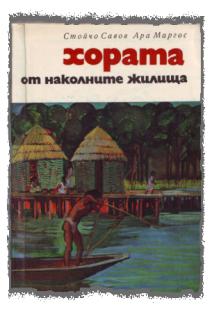
PEOPLE DWELLERS FROM THE VARNA LAKE
Authors: Ara Margos and Stoycho Savov

We wish to narrate a story and subsequently make few suppositions. The story concerns the Varna Chalcolithic (Stone-Copper) Civilization and the gold treasure found thence with dating from some 5000 B.C. Our main points should present early research on the site, which for various reasons before year 1972 — when the golden necropolis was found — didn't pose much interest to archaeological research and remained in shadow.
Earliest notifications on the Varna Lake (called "Gebedje" in turkish) came from Karel Skorpil in the period 1921-23. When excavation work was held on the littoral, several things happened worthy of scientific announcement. On the East end, artificially opened to the Black Sea bay, a flooding caused change in the flora and fauna of the lake. New marine species were brought to habitat in the estuary and even dolphins could be found in the lake. However, on the western end of the diameter some 2000 meters from the shore, there became change in the salinity due to fresh influx of river water in the adjoining Beloslav lake. The latter got its incursions from the Provadiya and Devnya rivers, which created plateau effect on Beloslav and flattening towards the Gebedje with denudation of areas around the lake. Thus, further excavation in the region led to digging out large quantities of mud from the lake's bottom and therein were found rich archaeological material — consisting of wooden pillars, large variety of stone implements, bone materials, clay reproductions, etc. The site was named appropriately belonging to the Diluvium and assumptions were made about prehistoric lake-dwelling culture in the region. See the map below with preponderance on site № 1 (Strashimirovo), site № 2 (Ezerovo I) and site № 3 (Ezerovo II).
The next episode on Varna Lake began in the 1960s. For long time bulgarian archaeologists didn't pay attention to the finds and reports from K. Skorpil. Short notes were made occasionally by Vasil Mikov in 1933 and 1950, when the latter was curator in the National Archaeological Museum. That precluded a hypothesis that Varna lake-dwellers were part of a larger cultural space that encompassed similar civilization edifice and branching to related geographical areal. The excavation works in 1960 and 1964 gave new impetus to research workers. The eastern end of the lake yielded new and even more interesting artifacts. On the shores of the isthmus there surfaced several localities dating from the Bronze Age, with bronze tools and weaponry, painted geometric pottery, and earthen ritual burials. Wide evidence for domestication culture with housing, boating facilities, hunt ganging, religious symbols et cetera were quarried. A proto-barbarian civilization was evidently inhabiting the region, but links to the flourishing capital centers in the Mediterranean, Mesopotamia and Egypt were still difficult to establish. See the main map for details at site № 4 (Varna I), site № 5 (Varna II) and site № 6 (Asparuhovo).

What is the case here in general and specifically to dating the sites? Shells of the Mediterranean mollusk Dentalium Spondylius were found in the lowest stratum of the dugout, which referred the thinking of some geologists in the 1930s (J. Radev, and G. Bonchev) towards a transgression to Alluvium. But even more original was the thinking of K. Skorpil himself. He made a wide detour of the littoral and established a sand limes to a depth of 2000 m. inland. Then he calculated that given a sand-gravel limes at cotta 600 m. — well-known before him to belong to the First Bulgarian state of Asparuh (circa 681) — this produces a littoral of 600 m. for 1200 years; thus, the total littoral should be estimated at approximately 4000 years of age.
Conclusion: — The Varna Chalcolith took shape earlier than Sumer and Egypt. An abrupt climatic and geographical changes that occurred at the end of the fifth millennium B.C. checked the natural development of the first human civilization in Europe by hundreds of years. If the gold find from 1972 in a necropolis from site № 4 (Varna I) is dated with radiocarbon C-14 and it is not displaced from somewhere else, then we can show the birthplace of the earliest civilized society and the appearance of the first state's realm in the world.

Note: This photo from wooden pillars of site № 3 (Ezerovo II) is published for first time.
***
Pictures 1, 2, 3 & 4: These photographs are taken from diggings of the innermost part of the lake — viz., site № 1 (Strashimirovo) which properly belongs to the Beloslav lake, 2 km inland. The littoral then propagates towards the lagoon, where at the estuary is situated the true Varna necropolis or City of the Dead, ditto.
|
(i). Polished stone hammers.
|
|
(ii). Hammers made of elk's horn.
|
|
(iii). Clay modeling yet unpainted.
|
|
(iv). Bone utensils of various size.
|
Addendum: Complementary information on Varna Chalcolith can be found also in Ivan Ivanov short monograph,
http://www.archive.org/details/BirthOfEuropeanCivilization
Copyright © 2009 by the author.